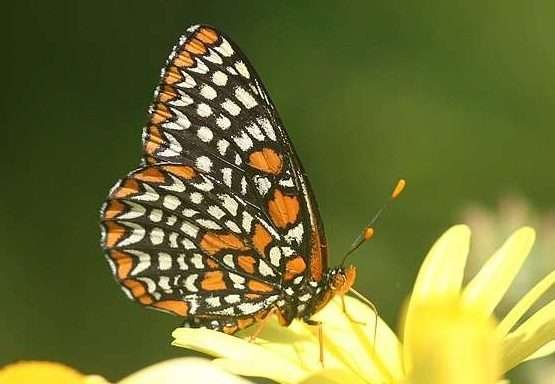
 A few summers ago, I was walking my dog in a pasture near my house when a butterfly landed on my bare leg. It was a medium-sized black butterfly with orange crescents along the margins of its wings and rows of white dots adjacent to the border. Its antennae were tipped with orange clubs. On the underside, the butterfly displayed a striking checkerboard pattern of orange, black, and white.
A few summers ago, I was walking my dog in a pasture near my house when a butterfly landed on my bare leg. It was a medium-sized black butterfly with orange crescents along the margins of its wings and rows of white dots adjacent to the border. Its antennae were tipped with orange clubs. On the underside, the butterfly displayed a striking checkerboard pattern of orange, black, and white.
It was a Baltimore checkerspot (Euphydryas phaeton) – the first time I’d ever seen one.
Last summer, I watched two Baltimore checkerspots visit a patch of milkweed on our property. I learned about these butterflies from field biologist Bryan Pfeiffer, who describes them as “audacity on the wing” and “some of the most shocking and beautiful butterflies on the continent.”
The Baltimore checkerspot was named for George Calvert, the first Baron Baltimore (1580-1632), who was involved in the settling of Maryland, as its colors matched the orange and black of his family crest. This butterfly is Maryland’s official state insect. Though it was once common, it is now rare in the state due to habitat loss.
Baltimore checkerspots prefer wetland habitats such as marshes, wet meadows, bogs, and shrub swamps. They can also be found in dry fields and open oak woodlands. Baltimore checkerspots range from Nova Scotia west to southeast Manitoba, south through the eastern United States to northern Georgia and northeastern Oklahoma. They are not abundant across their range; populations are very localized.

 Baltimore checkerspots fly from mid-June through July. From a distance, they may appear all black. They sip nectar from a variety of flowers, including several milkweed species, spreading dogbane, and black-eyed Susan. Many of the plants they feed on contain toxic chemicals, making the butterflies unpalatable to birds and mammals. Their orange and black coloration is believed to serve as a warning to predators.
Baltimore checkerspots fly from mid-June through July. From a distance, they may appear all black. They sip nectar from a variety of flowers, including several milkweed species, spreading dogbane, and black-eyed Susan. Many of the plants they feed on contain toxic chemicals, making the butterflies unpalatable to birds and mammals. Their orange and black coloration is believed to serve as a warning to predators.
These butterflies only have one brood per year. Male butterflies set up territories or patrol for mates. After mating, the female lays clusters of 70 to 100 yellow, dome-shaped eggs on the undersides of leaves. White turtlehead, a wetland plant, is the preferred host for Baltimore checkerspots.
As wetland habitat has shrunk, the butterflies have adapted to use other plants, such as the non-native but very common English plantain, which grows in dry fields, as well as white ash and false foxglove. They seek out host plants that contain iridoid glycosides, which make their caterpillars distasteful to birds.
The eggs hatch after three weeks. The orange caterpillars have black bands and bristly, black spines. They crawl to the tip of the host plant and spin a communal web. The web provides protection from predators and parasitic wasps while they feed. As the caterpillars grow, they shed their skins, going through three or four instars, or life stages.
In early fall, they weave a pre-hibernation web at the base of the host plant (or nearby) and stop feeding. Later in fall, groups of caterpillars roll up leaves and debris on the ground and spin a hibernation web around them, which lasts all winter.
Unlike most butterflies, Baltimore checkerspots overwinter as caterpillars. They have antifreeze chemicals that enable them to partially solidify without damaging their bodies and then thaw out again.

 In spring, the caterpillars break out of their winter shelter and feed individually. At this time, they may feed on plants such as willows and arrowheads. Then, each caterpillar forms a bluish-white chrysalis with black and orange bumps and spots. Inside, it transforms into an adult butterfly, and after two weeks, it emerges to grace the air.
In spring, the caterpillars break out of their winter shelter and feed individually. At this time, they may feed on plants such as willows and arrowheads. Then, each caterpillar forms a bluish-white chrysalis with black and orange bumps and spots. Inside, it transforms into an adult butterfly, and after two weeks, it emerges to grace the air.
There’s still time to look for this dazzling butterfly this summer. If one has a good view of the entire butterfly, the Baltimore checkerspot is unmistakable. Two other species of checkerspot inhabit our region: Harris’s checkerspot and the silvery checkerspot. Harris’s has a similar – though less striking – pattern on its underside, but the topside is quite different. The rare silvery checkerspot bears no resemblance to the Baltimore.
To attract Baltimore checkerspots and other butterflies to your yard, plant native milkweed, black-eyed Susan, mountain mint, and, if you have a sunny, wet area, white turtlehead.
Susan Shea is a naturalist, writer, and conservationist based in Vermont.
Photo of butterfly courtesy Wikipedia user Alison Hunter. Illustration by Adelaide Murphy Tyrol. Caterpillar photo courtesy .
The Outside Story is assigned and edited by Northern Woodlands magazine and sponsored by the Wellborn Ecology Fund of New Hampshire Charitable Foundation: nhcf.org.








Recent Comments